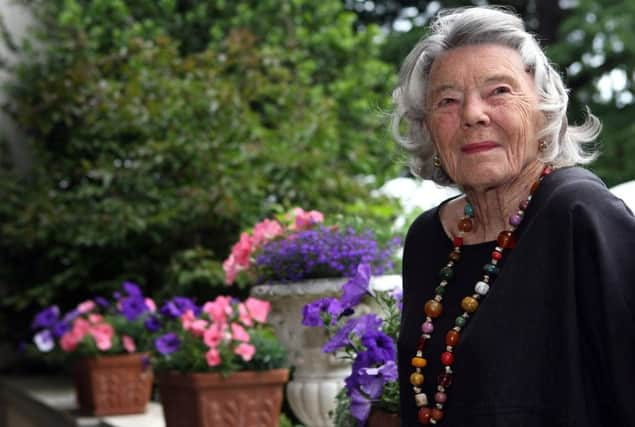Rosamunde Pilcher


Sitting at the kitchen table in her house in Tayside and banging away on an old-fashioned typewriter, Rosamunde Pilcher was in her sixties when she wrote the book that set her on the way to becoming one of the most commercially successful authors in Britain in the latter part of the 20th century.
She had spent years churning out romances for Mills & Boon, but The Shell Seekers took her writing and popularity to a new level when it appeared in 1988. She had written 22 previous novels between 1949 and 1984 and she was 64 when The Shell Seekers appeared.
Advertisement
Hide AdAdvertisement
Hide AdTold largely in flashback by a protagonist in her sixties and drawing on Pilcher’s own memories of her early life in Cornwall, it sprawled across several generations and 500 pages and sold millions of copies worldwide.
Other bestsellers followed, including Winter Solstice (2000), which was set in a fictionalised version of the Dornoch area in Sutherland, where Pilcher had a holiday house. Place names were changed, but locations were readily identifiable from detailed descriptions in a story of two elderly friends who move from Hampshire to Scotland after a personal tragedy.
Latterly, Pilcher’s main home was in Longforgan, near Dundee, where her late husband’s family had made their fortune in jute. There is a street that bears her name in Longforgan.
Although Pilcher was hardly unknown in Britain, she was phenomenally successful in Germany and many of her stories were dramatised for German television. One Scottish fan commenting on line at news of Pilcher’s death, said: “It was my German pen pal who spurred me on to read her.”
A film version of Winter Solstice shot on location in Sutherland with Sinead Cusack, Geraldine Chaplin and Peter Ustinov. And it was not only cast and crew who came to Scotland – fans followed them and a local company organised tours. The television company ZDF made Pilcher’s Scotland and Pilcher’s Cornwall.
She was born Rosamunde Scott in 1924 in the village of Lelant, near the picturesque Cornish fishing port of St Ives. Her mother’s family were from Orkney and she could reputedly trace her ancestry back to Sir Walter Scott. Her father worked for the Indian civil service and was away in Burma for much of her childhood. Pilcher had her first story published when she was in her teens – anywhere between 15 and 19 depending on which account you read. Rather than pursuing a career as a novelist from the outset, she went to secretarial college, as so many bright women did at that time.
During the Second World War she served as a Wren and in 1946 married Major Graham Pilcher, who won the Military Cross while serving with the Black Watch in the Netherlands. She met him while he was recovering from injuries in Cornwall. They moved to the Dundee area where, following family tradition, her husband became a prominent figure in the jute industry. They had five children, one of whom died at birth, and in her spare moments she continued writing.
Mills & Boon, the English publisher famous for its huge output of undemanding romantic tosh, provided an outlet for her. Her first novel, Half-Way to the Moon, was published in 1949 under the name Jane Fraser.
Advertisement
Hide AdAdvertisement
Hide AdAs Fraser and under her own married name, she turned out novels at the rate of one every year or two without attracting much fanfare until the appearance of The Shell Seekers, which was much more ambitious than anything she had written previously. The Shell Seekers are not actually characters in the book, but figures in a painting by the protagonist Penelope Keeling’s father, an artist who has become increasingly well regarded after his death, meaning a sentimental keepsake has become rather valuable. At the start of the novel Penelope is 64 and has discharged herself from the hospital where she was taken after a heart attack. The novel relates her life in flashback, “done with the ease and charm of a kindly friend showing you a photograph album” said the New York Times.
“Mrs Pilcher has paced her tale perfectly: just when you want to know another thread, that thread is introduced; at the very moment you want to get back to Penelope, that is where you are taken,” said the reviewer. “There is a healthy suspense, too, about what Penelope intends to do with her father’s great masterpiece.”
While descriptions of Cornwall and Scotland painted a vivid picture for many, other readers – particularly critics – found Pilcher’s long descriptions of people, their clothing and houses tiresome and her world just a little too cosy, nostalgic and romanticised.
Pilcher accepted that her books did not appeal to everyone; she knew her market: “Mostly, I would say, the older lady or the family lady”. She added: “The mother doesn’t mind handing my books over to her daughter because they’re not full of sex, drugs and shopping.”
It may have been a niche market, but it was a sufficiently large niche market to make her one of the ten richest women in Britain, according to one newspaper report in the 1990s.
Graham Pilcher died in 2009. She is survived by four children including the novelist Robin Pilcher, 14 grandchildren and 17 great-grandchildren.
Brian Pendreigh